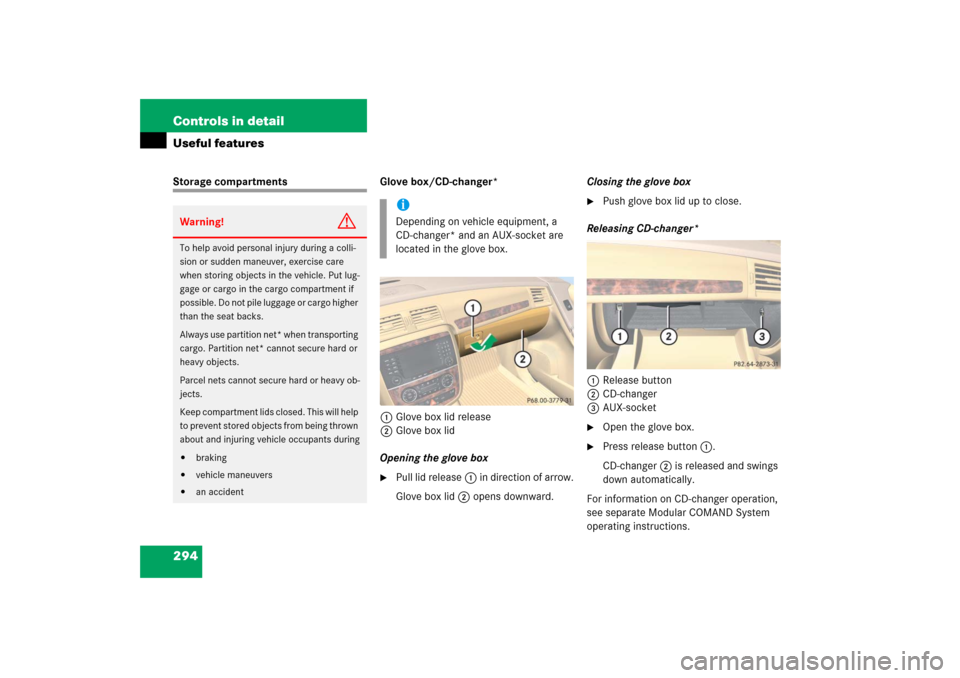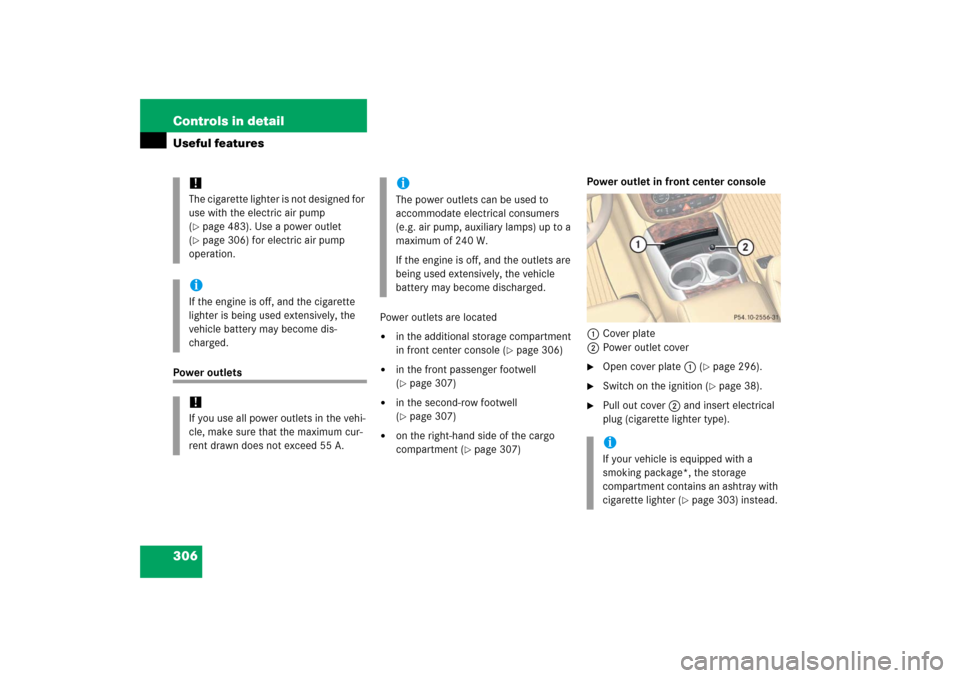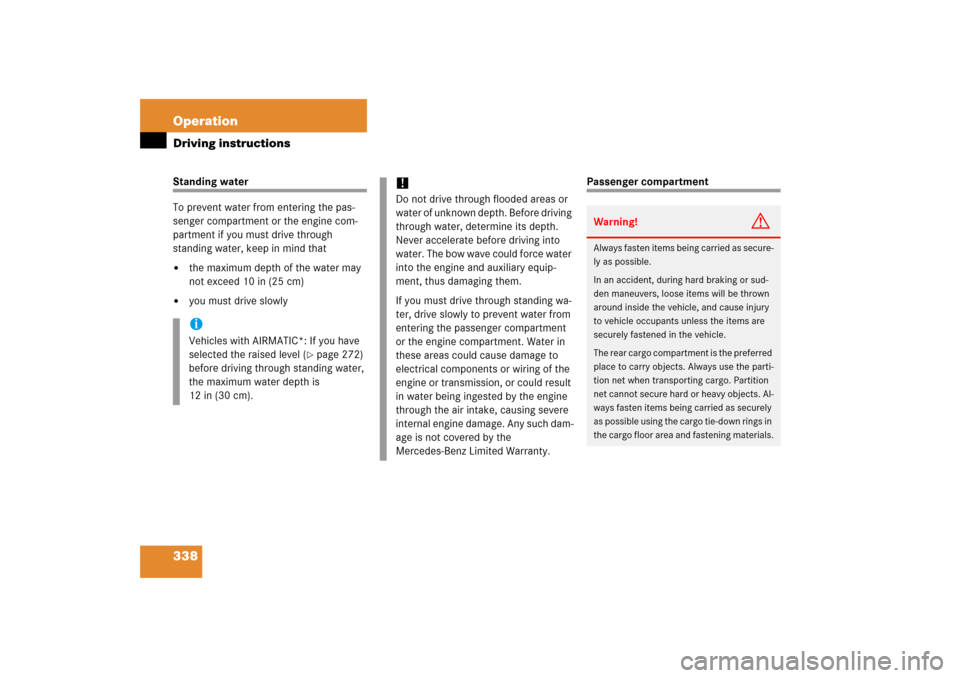Page 295 of 561

294 Controls in detailUseful featuresStorage compartments Glove box/CD-changer*
1Glove box lid release
2Glove box lid
Opening the glove box
�
Pull lid release1 in direction of arrow.
Glove box lid2 opens downward.Closing the glove box
�
Push glove box lid up to close.
Releasing CD-changer*
1Release button
2CD-changer
3AUX-socket
�
Open the glove box.
�
Press release button 1.
CD-changer 2 is released and swings
down automatically.
For information on CD-changer operation,
see separate Modular COMAND System
operating instructions.
Warning!
G
To help avoid personal injury during a colli-
sion or sudden maneuver, exercise care
when storing objects in the vehicle. Put lug-
gage or cargo in the cargo compartment if
possible. Do not pile luggage or cargo higher
than the seat backs.
Always use partition net* when transporting
cargo. Partition net* cannot secure hard or
heavy objects.
Parcel nets cannot secure hard or heavy ob-
jects.
Keep compartment lids closed. This will help
to prevent stored objects from being thrown
about and injuring vehicle occupants during�
braking
�
vehicle maneuvers
�
an accident
iDepending on vehicle equipment, a
CD-changer* and an AUX-socket are
located in the glove box.
Page 307 of 561

306 Controls in detailUseful featuresPower outletsPower outlets are located
�
in the additional storage compartment
in front center console (
�page 306)
�
in the front passenger footwell
(�page 307)
�
in the second-row footwell
(�page 307)
�
on the right-hand side of the cargo
compartment (
�page 307)Power outlet in front center console
1Cover plate
2Power outlet cover
�
Open cover plate1 (
�page 296).
�
Switch on the ignition (
�page 38).
�
Pull out cover 2 and insert electrical
plug (cigarette lighter type).
!The cigarette lighter is not designed for
use with the electric air pump
(�page 483). Use a power outlet
(�page 306) for electric air pump
operation.
iIf the engine is off, and the cigarette
lighter is being used extensively, the
vehicle battery may become dis-
charged.!If you use all power outlets in the vehi-
cle, make sure that the maximum cur-
rent drawn does not exceed 55 A.
iThe power outlets can be used to
accommodate electrical consumers
(e.g. air pump, auxiliary lamps) up to a
maximum of 240 W.
If the engine is off, and the outlets are
being used extensively, the vehicle
battery may become discharged.
iIf your vehicle is equipped with a
smoking package*, the storage
compartment contains an ashtray with
cigarette lighter (
�page 303) instead.
Page 339 of 561

338 OperationDriving instructionsStanding water
To prevent water from entering the pas-
senger compartment or the engine com-
partment if you must drive through
standing water, keep in mind that�
the maximum depth of the water may
not exceed 10 in (25 cm)
�
you must drive slowly
Passenger compartment
iVehicles with AIRMATIC*: If you have
selected the raised level (
�page 272)
before driving through standing water,
the maximum water depth is
12 in (30 cm).
!Do not drive through flooded areas or
water of unknown depth. Before driving
through water, determine its depth.
Never accelerate before driving into
water. The bow wave could force water
into the engine and auxiliary equip-
ment, thus damaging them.
If you must drive through standing wa-
ter, drive slowly to prevent water from
entering the passenger compartment
or the engine compartment. Water in
these areas could cause damage to
electrical components or wiring of the
engine or transmission, or could result
in water being ingested by the engine
through the air intake, causing severe
internal engine damage. Any such dam-
age is not covered by the
Mercedes-Benz Limited Warranty.
Warning!
G
Always fasten items being carried as secure-
ly as possible.
In an accident, during hard braking or sud-
den maneuvers, loose items will be thrown
around inside the vehicle, and cause injury
to vehicle occupants unless the items are
securely fastened in the vehicle.
The rear cargo compartment is the preferred
place to carry objects. Always use the parti-
tion net when transporting cargo. Partition
net cannot secure hard or heavy objects. Al-
ways fasten items being carried as securely
as possible using the cargo tie-down rings in
the cargo floor area and fastening materials.